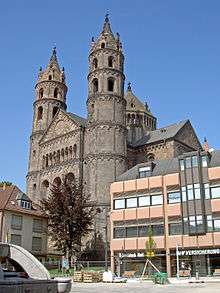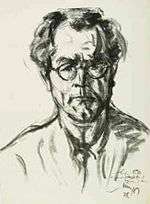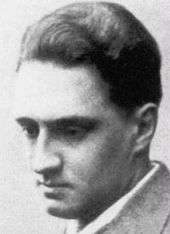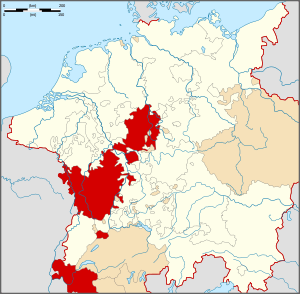Worms, Germany
| Worms | ||
|---|---|---|
|
Nibelungen Bridge over the Rhine at Worms | ||
| ||
 Worms | ||
| Coordinates: 49°37′55″N 08°21′55″E / 49.63194°N 8.36528°ECoordinates: 49°37′55″N 08°21′55″E / 49.63194°N 8.36528°E | ||
| Country | Germany | |
| State | Rhineland-Palatinate | |
| District | Urban district | |
| Government | ||
| • Lord Mayor | Michael Kissel (SPD) | |
| Area | ||
| • Total | 108.73 km2 (41.98 sq mi) | |
| Population (2015-12-31)[1] | ||
| • Total | 82,102 | |
| • Density | 760/km2 (2,000/sq mi) | |
| Time zone | CET/CEST (UTC+1/+2) | |
| Postal codes | 67547–67551 | |
| Dialling codes |
06241, 06242, 06246, 06247 | |
| Vehicle registration | WO | |
| Website | www.worms.de | |


Worms (German: [vɔʁms]) is a city in Rhineland-Palatinate, Germany, situated on the Upper Rhine about 60 kilometres (40 miles) south-southwest of Frankfurt-am-Main. It had some 85,000 inhabitants as of 2016.
A pre-Roman foundation, Worms was the capital of the Kingdom of the Burgundians in the early 5th century and hence the scene of the medieval legends referring to this period, notably the first part of the Nibelungenlied. Worms has been a Roman Catholic bishopric since at least 614, and was an important palatinate of Charlemagne. Worms Cathedral is one of the Imperial Cathedrals and among the finest examples of Romanesque architecture in Germany. Worms prospered in the High Middle Ages as an Imperial Free City. Among more than a hundred Imperial Diets held at Worms, the Diet of 1521 (commonly known as the Diet of Worms) ended with the Edict of Worms in which Martin Luther was declared a heretic. Today, the city is an industrial centre and is famed as the origin of Liebfraumilch wine. Other industries include chemicals and metal goods.
Geography
Geographic location
Worms is located on the west bank of the Rhine River between the cities of Ludwigshafen and Mainz. On the northern edge of the city the Pfrimm flows into the Rhine, and on the southern edge the Eisbach (English "Ice Stream"), flows into the Rhine.
Boroughs
Worms has 13 boroughs (or "Quarters") around the city centre. They are as follows:
| Name | Population | Direction and distance from city centre |
|---|---|---|
| Abenheim | 2,744 | Northwest (10 km) |
| Heppenheim | 2,073 | Southwest (9 km) |
| Herrnsheim | 6,368 | North (5 km) |
| Hochheim | 3,823 | Northwest |
| Horchheim | 4,770 | Southwest (4.5 km) |
| Ibersheim | 692 | North (13 km) |
| Leiselheim | 1,983 | West (4 km) |
| Neuhausen | 10,633 | North |
| Pfeddersheim | 7,414 | West (7 km) |
| Pfiffligheim | 3,668 | West |
| Rheindürkheim | 3,021 | North (8 km) |
| Weinsheim | 2,800 | Southwest (4 km) |
| Wiesoppenheim | 1,796 | South West (5.5 km) |
Climate
The climate in the Rhine River Valley is very temperate in winter and quite enjoyable in summer. Rainfall is below average for the surrounding areas. Winter snow accumulation is very low and often melts quickly.
History
Antiquity
Worms was anciently a Celtic city named Borbetomagus, perhaps meaning "water meadow".[2] Later it was conquered by the Germanic Vangiones. In 14 BC, Romans under the command of Drusus captured and fortified the city, and henceforth a small troop of infantry and cavalry were garrisoned there. The Romans knew the city as Augusta Vangionum, after the then-emperor and the local tribe; the German Worms developed from this name. The garrison grew into a small town with the regular Roman street plan, a forum, and temples for the main gods Jupiter, Juno, Minerva (whose temple was the site of the later cathedral), and Mars.

Roman inscriptions, altars, and votive offerings can be seen in the archaeological museum, along with one of Europe's largest collections of Roman glass. Local potters worked in the town's south quarter. Fragments of amphoras contain traces of olive oil from Hispania Baetica, doubtless transported by sea and then up the Rhine by ship.
During the disorders of 411–13 AD, the Roman usurper Jovinus established himself in Borbetomagus as a puppet-emperor with the help of King Gunther of the Burgundians, who had settled in the area between the Rhine and Moselle Rivers some years before. The city became the capital of the Burgundian kingdom under Gunther (also known as Gundicar). Few remains of this early Burgundian kingdom survive, because in 436 it was all but destroyed by a combined army of Romans (led by Aëtius) and Huns (led by Attila); a belt clasp found at Worms-Abenheim is a museum treasure. Provoked by Burgundian raids against Roman settlements, the combined Romano-Hunnic army destroyed the Burgundian army at the Battle of Worms (436), killing King Gunther. It is said that 20,000 were killed. The Romans led the survivors southwards to the Roman district of Sapaudia (modern day Savoy). The story of this war later inspired the Nibelungenlied.
Middle Ages
| Imperial City of Worms | ||||||||||
| Reichsstadt Worms | ||||||||||
| Free Imperial City of the Holy Roman Empire | ||||||||||
| ||||||||||
| Capital | Not specified | |||||||||
| Government | Republic | |||||||||
| Historical era | Middle Ages | |||||||||
| • | City founded | before 14 BCE | ||||||||
| • | Gained Reichsfreiheit | between 1074 and 1184 | ||||||||
| • | Concordat of Worms | 1122 | ||||||||
| • | Reichstag concluded Imperial Reform | 1495 | ||||||||
| • | Diet of Worms: Martin Luther banned | 1521 | ||||||||
| • | Sacked by French during War of Grand Alliance | 1689 | ||||||||
| • | Occupied by France | 1789–1816 | ||||||||
| • | Awarded to Hesse | 1816 | ||||||||
| ||||||||||
Worms has been a Roman Catholic bishopric since at least 614, with an earlier mention in 346. In the Frankish Empire, the city was the location of an important palatinate of Charlemagne, who built one of his many administrative palaces here. The bishops administered the city and its territory. The most famous of the early medieval bishops was Burchard of Worms.
Worms Cathedral (Wormser Dom), dedicated to St Peter, is one of the finest examples of Romanesque architecture in Germany. Alongside the nearby Romanesque cathedrals of Speyer and Mainz, it is one of the so-called Kaiserdome (Imperial Cathedrals). Some parts in early Romanesque style from the 10th century still exist, while most parts are from the 11th and 12th century, with some later additions in Gothic style (see the external links below for pictures).
Four other Romanesque churches as well as the Romanesque old city fortification still exist, making the city Germany's second in Romanesque architecture only to Cologne.
Worms prospered in the High Middle Ages. Having received far-reaching privileges from King Henry IV (later Emperor Henry III) as early as 1074, the city later became an Imperial Free City, being independent of any local ruler and responsible only to the Holy Roman Emperor himself. As a result, Worms was the site of several important events in the history of the Empire. In 1122 the Concordat of Worms was signed; in 1495, an Imperial Diet met here and made an attempt at reforming the disintegrating Imperial Circle Estates by the Imperial Reform. Most important, among more than a hundred Imperial Diets held at Worms, that of 1521 (commonly known as the Diet of Worms) ended with the Edict of Worms, in which Martin Luther was declared a heretic after refusing to recant his religious beliefs. Worms was also the birthplace of the first Bibles of the Reformation, both Martin Luther's German Bible and William Tyndale's first complete English New Testament by 1526.[3]
The city, known in medieval Hebrew by the name Varmayza or Vermaysa (ורמיזא, ורמישא), was a centre of medieval Ashkenazic Judaism. The Jewish community was established there in the late 10th century, and Worms's first synagogue was erected in 1034. In 1096, eight hundred Jews were murdered by crusaders and the local mob. The Jewish Cemetery in Worms, dating from the 11th century, is believed to be the oldest surviving in situ cemetery in Europe. The Rashi Synagogue, which dates from 1175 and was carefully reconstructed after its desecration on Kristallnacht, is the oldest in Germany. Prominent students, rabbis, and scholars of Worms include Shlomo Yitzhaki (Rashi) who studied with R. Yizhak Halevi sgan haleviya, Elazar Rokeach, Maharil, and Yair Bacharach. At the rabbinical synod held at Worms at the turn of the 11th century, Rabbi Gershom ben Judah (Rabbeinu Gershom) explicitly prohibited polygamy for the first time. For hundreds of years until Kristallnacht in 1938, the Jewish Quarter of Worms was the centre of Jewish life. Worms today has only a very small Jewish population, and a recognizable Jewish community as such no longer exists. However, after renovations in the 1970s and 1980s, many of the buildings of the Quarter can be seen in a close-to-original state, preserved as an outdoor museum.
Modern era
In 1689 during the Nine Years' War, Worms (like the nearby towns and cities of Heidelberg, Mannheim, Oppenheim, Speyer and Bingen) was sacked by troops of King Louis XIV of France, though the French only held the city for a few weeks. In 1743 the Treaty of Worms was signed, forming a political alliance between Great Britain, Austria and the Kingdom of Sardinia. In 1792 the city was occupied by troops of the French First Republic during the French Revolutionary Wars. The Bishopric of Worms was secularized in 1801, with the city being annexed into the First French Empire. In 1815 Worms passed to the Grand Duchy of Hesse in accordance with the Congress of Vienna and subsequently administered within Rhenish Hesse.
After the Battle of the Bulge, Allied Armies advanced into the Rhineland in preparation for a planned massive assault across the Rhine into the heart of the Reich. Worms was a German strong point in the southern Rhineland on the West bank of the Rhine and the German forces there resisted the Allied advance tenaciously. Worms was thus heavily bombed by the Royal Air Force during the last few months of World War II — in two attacks, on Feb. 21 and March 18, 1945. A post-war survey estimated that 39 per cent of the town's developed area was destroyed. The RAF attack on Feb. 21 was aimed at the main train station, on the edge of the inner city, and at chemical plants southwest of the inner city. The attack, however, also destroyed large areas of the city centre. The attack was carried out by 334 bombers that in a few minutes rained 1,100 tons of bombs on the inner city. The Worms Cathedral was among the buildings set afire in the resulting conflagration. The Americans did not enter the city until the Rhine crossings began after the seizure of the Remagen Bridge.
In the attacks, 239 inhabitants were killed and 35,000 (60 percent of the population of 58,000) were rendered homeless. A total of 6,490 buildings were severely damaged or destroyed. After the war, the inner city was rebuilt, mostly in modern style. Postwar, Worms became part of the new state of Rhineland-Palatinate; the borough Rosengarten, on the east bank of the Rhine, was lost to Hesse.
Worms today fiercely vies with the cities Trier and Cologne for the title of "Oldest City in Germany." Worms is the only German member of the Most Ancient European Towns Network.[4][5] A multimedia Nibelungenmuseum was opened in 2001, and a yearly festival right in front of the Dom, the Cathedral of Worms, attempts to recapture the atmosphere of the pre-Christian period.
In 2010 the Worms synagogue was firebombed. Eight corners of the building were set ablaze, and a Molotov cocktail was thrown at a window. There were no injuries. Kurt Beck, Minister-President of Rhineland-Palatinate, condemned the attack and vowed to mobilize all necessary resources to find the perpetrators, saying, "We will not tolerate such an attack on a synagogue".[6]
Main sights
- The reconstructed (1886–1935) new-Romanesque Cathedral, dedicated to St Peter (12th-13th century)
- Reformation Memorial church of the Holy Trinity, the city's largest Protestant church (17th century)
- St Paul’s Church (Pauluskirche) (13th century)
- St Andrew’s Collegiate Church (Andreaskirche) (13th century)
- St Martin’s Church (Martinskirche) (13th century)
- Liebfrauenkirche (15th century)
- Luther Monument (Lutherdenkmal) (1868) (designed by Ernst Rietschel)
- Rashi Synagogue
- Jewish Museum in the Rashi-House
- Jewish Cemetery
- Nibelungen Museum, celebrating the Middle High German epic poem Das Nibelungenlied (The Song of the Nibelungs)
International relations

Twin towns — sister cities
Worms is twinned with:
Other relations
Notable citizens
A-K
- Samuel Adler, (1809-1891), noted Reform rabbi, was born in Worms[7]
- Curtis Bernhardt, (1899-1981), German film director
- Hans Diller (1905–1977), German classical scholar specializing in Ancient Greek medicine
- Ludwig Edinger, (1855-1918), German anatomist and neurologist
- Ferdinand Eberstadt (1808-1888), textile merchant and mayor
- Hans Folz (1435/1440-1513), in Worms, notable medieval German author
- Friedrich Gernsheim, (1839-1916), German composer, conductor and pianist
- Florian Gerster (born 1949), politician (SPD), former chairman of the Federal Employment Agency
- Petra Gerster, (born 1955), German television journalist (ZDF)
- Johann Nikolaus Götz, (1721-1781), poet
.jpg)
- Siegfried Guggenheim (1873-1961), lawyer, notary and art collector
- Heribert of Cologne, born ~ 970 in Worms died 1021, archbishop-elector of Cologne and Chancellor of the Holy Roman Empıre.
- Richard Hildebrandt, (1897-1952), politician in Nazi Germany and member of the Reichstag
- Timo Hildebrand, (born 1979), German national footballer, born in Worms
- Hans Hinkel (1901-1960), German journalist and Nazi cultural functionary
- Hanya Holm, (1893-1992), choreographer, dancer, educator and one of the founders of American Modern Dance
- Vladimir Kagan, (1927-2016), furniture designer
L-Z

- Solomon Loeb (1828-1903) American banker and philanthropist
- Rabbi Meir of Rothenburg, (1215-1293), German rabbi and poet, a major author of the tosafot on Rashi's commentary on the Talmud
- Conrad Meit (or Conrat Meit), Renaissance sculptor, mostly in the Low Countries, b. 1480s in Worms; d. 1550/1551 in Antwerp
- Saint Erentrude, or Erentraud, (~650 in Worms –710) is a virgin saint of the Roman Catholic Church
- Rabbi Shlomo Yitzhaki (Rashi), (1040-1105), who studied in the Worms Yeshiva in 1065 to 1070
- Hugo Sinzheimer, (1875-1945), German legal scholar, member of the Constitutional Convention of 1919
- Hermann Staudinger (1881-1965), organic chemist, Nobel Prize in Chemistry 1953

- Rudi Stephan, (1887-1915), German composer
- Monika Stolz (born 1951), politician (CDU), Member of Landtag Baden-Württemberg since 2001
- Ida Straus, (1849-1912), wife of Isidor Straus, co-owner of the Macy's department store, and famously loyal to her husband on board the RMS Titanic
- Emil Stumpp, (1886-1941), cartoonist, died in jail after doing an unflattering portrait of Adolf Hitler
See also
References
- ↑ "Gemeinden in Deutschland mit Bevölkerung am 31. Dezember 2015" (PDF). Statistisches Bundesamt (in German). 2016.
- ↑ "Etymologie". Etymologie.info.
damit der Bedeutung von 'Borbetomagus' = dt. 'Wasserwiese'
- ↑ Teems, David. "Tyndale: The man who gave God an English voice." Nashville: Thomas Nelson (2012). Chapter 4.
- ↑ MAETN (1999). "diktyo". classic-web.archive.org. Archived from the original on October 22, 2005. Retrieved 19 May 2011.
- ↑ Worms city council (2011). "worms.de > Kultur > älteste deutsche Stadt". worms.de. Retrieved 19 May 2011.
- ↑ "Worms synagogue fire-bombed". Haaretz. 17 May 2010.
- ↑ Who Was Who in America, Historical Volume, 1607-1896. Marquis Who's Who. 1967.
Further reading
- Roemer, Nils H. German City, Jewish Memory: The Story of Worms (Brandeis University Press, 2010) ISBN 978-1-58465-922-8 online review
External links
| Wikimedia Commons has media related to Worms. |
| Wikivoyage has a travel guide for Worms. |
- The Official website of the city of Worms (English)
- Nibelungenmuseum website (English)
- wormser-dom.de, website of the Worms Cathedral with pictures (German) (click on the "Bilder" link in the left panel)
- Wormatia, Worms football club (German)



